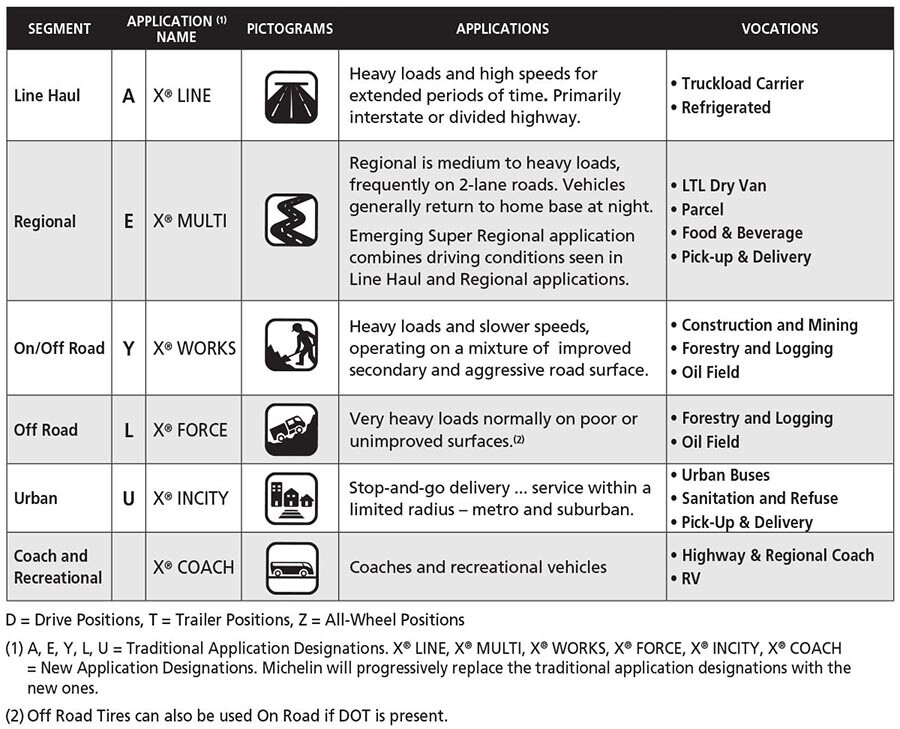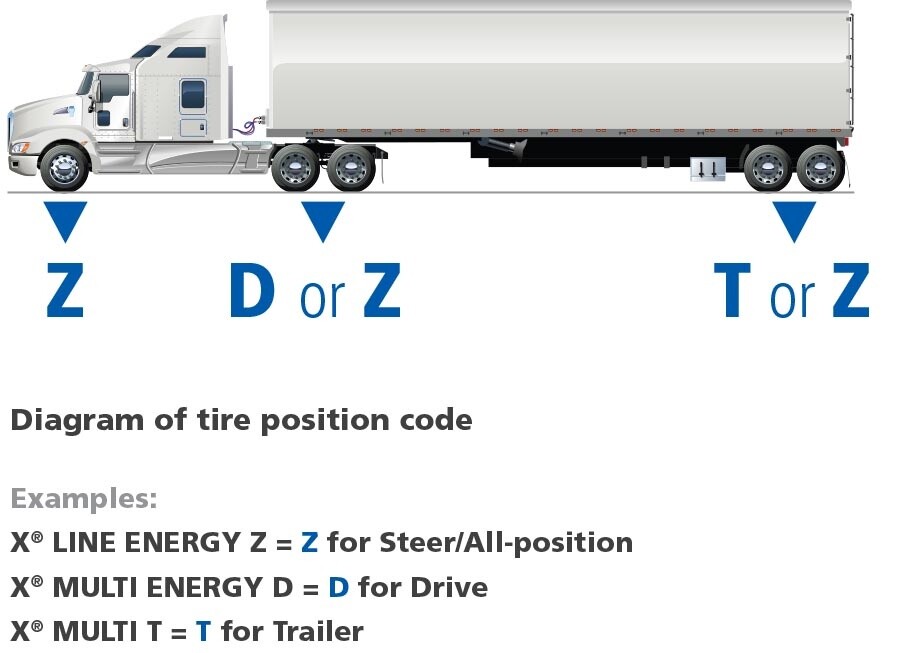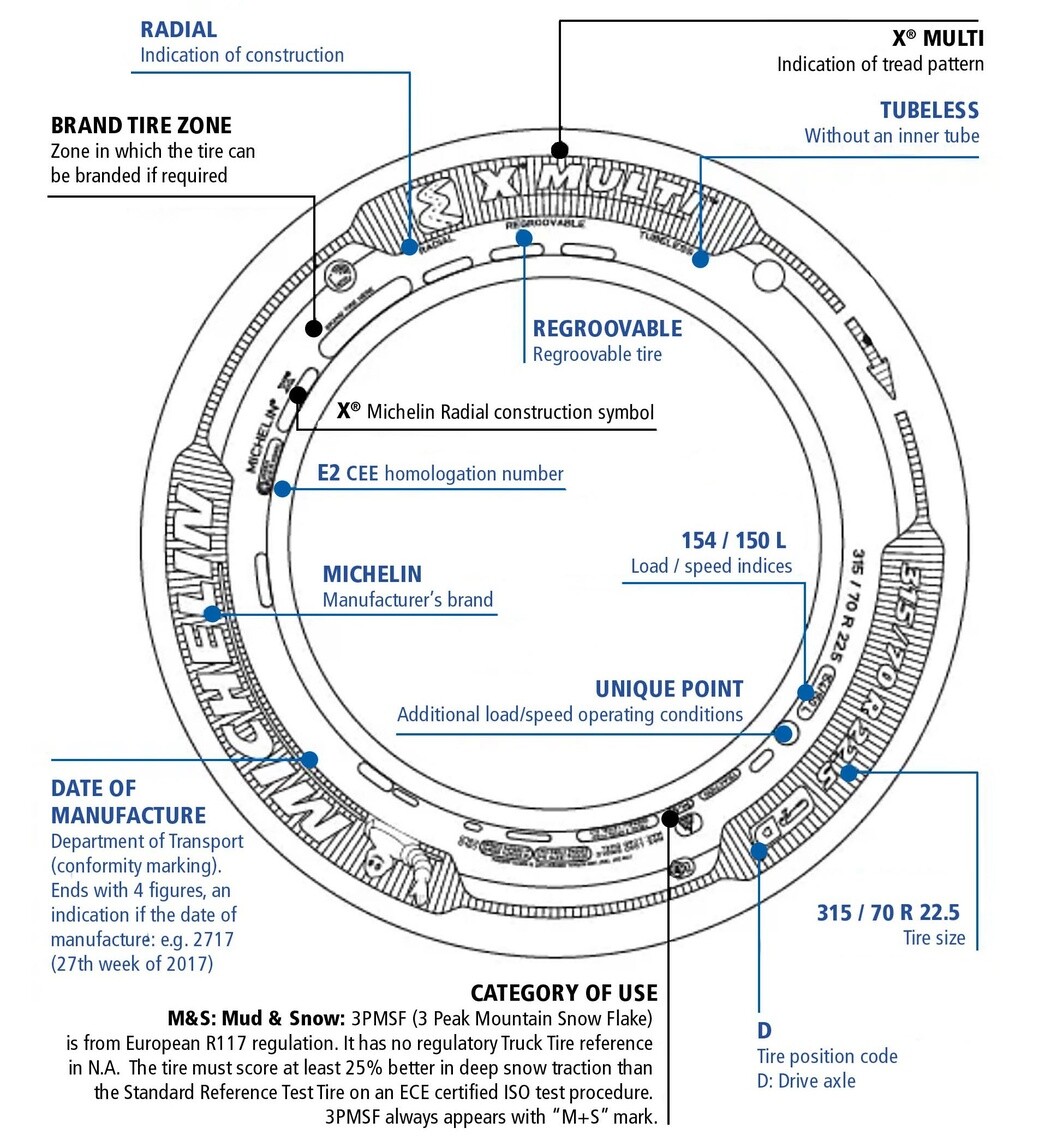
Image Michelin truck tyre mounted
pneu michelin monté sur camion
Truck and Bus Tire Basics
Tire Usage Reminders:
When choosing a tire, please follow all original equipment recommendations (or official governing body) related to size, load, speed, fitments, etc.; and all applicable local laws.
- Conditions of Use: Take into account all possible tire usage conditions when selecting a tire so it will perform to expectations.
- Vehicle Modifications: If a vehicle has been modified from the manufacturer's original specifications, please verify tire usage complies with original equipment requirements related to size, load, speed, fitments, etc.
- Any used or second-hand tire or one that has been involved in an accident must be carefully checked by a professional before mounting in order to guarantee the user’s safety and compliance with local safety regulations. (see correct tire installation and inflation procedures).
- Misuse or improper tire selection can also contribute to early wear of some mechanical parts.
How to choose a tire?
In order to drive safely and maximize profitability, it’s important to properly equip your vehicles. Remember these four steps to help you choose the right tire!
STEP 1: Determine the Right Tire Size
- The size must be approved by the manufacturer and must (at minimum) match the maximum load capacity of the axle.
- The maximum axle load is given by the vehicle manufacturer based on certain criteria. Equipping this axle with tires able to support a heavier load does not allow it to exceed the load approved by the manufacturer.
- Each tire size corresponds to one or more suitable wheels, particularly in terms of rim width: consult the "Truck Tire Databook” and/or the manufacturer’s recommendations.
- Mounting a tire on an unapproved rim can lead to: deterioration of the wheel and/or tire, a non-optimized footprint, abnormal wearing of the carcass, which can adversely affect the safety, behavior, grip and life of the tire.
STEP 2: Define the correct tire usage
- The MICHELIN truck tire line is composed of six ranges, meeting the different usage needs of drivers.
- In order to choose the right tire, each range's use and benefits must be taken into account.
PROPER APPLICATION
URBAN TIRES: U or X® INCITY
The tires with the “U” or “INCITY” designation are designed and optimized for urban applications and should not be used in non-urban/suburban applications including but not limited to, line haul and RV/motorhomes/coaches. These aforementioned applications may subject the tires to continuous use over an extended period of time. This could lead to heat build up and may cause the tire to fail prematurely and/or suddenly.
ON/OFF ROAD TIRES: Y or X® WORKS and L or X® FORCE
The tires with “Y” or “X® WORKS” and “L” or “X® FORCE” as the third character in the tread designations are designed and optimized for on/off road applications and are speed restricted. These tires should not be used in applications that operate the tires continuously on highway over an extended period of time or at speeds that exceed the speed rating of the tire. This could lead to heat build up and cause premature or sudden tire failure.
Tires with the “Y” or “X® WORKS”designation are for applications expected to be 80% On-road use and 20% Off-road use. They have a maximum speed of 65 - 68 mph depending on the tire.
Tires with the “L” or “X® FORCE” designation are for applications expected to be 20% On-road use and 80% Off-road use. Some of the “L” or “X® FORCE” designated tires have a maximum speed of 50 mph while others have maximum speeds of 56, 62 and of 68 mph.
The Tire and Rim Association (TRA) permits operating a 65 mph rated tire at higher speeds with a reduced load and increased inflation. No such permission is granted by TRA for tires with speed rating rated below 65 mph.
PRODUCT NAMING AND SEGMENTATION
The specific tread design used should only be considered after the vehicle type and user vocation has been examined.
There are several categories of tire service applications:

Product naming and segmentation
STEP 3: Identify the right benefit
MICHELIN tires offer benefits according to the specific needs of drivers.
STEP 4: Choose the right tread
There are rules that must be followed when choosing the tire tread pattern.

Picto le choix du pneu page 18 Help and Advice
OTHER RECOMMENDATIONS
Install only "Z" treads on steering axles.
These tread patterns are designed and manufactured to meet the specific driving demands of motor vehicle steering axles: load capacity, sway with dynamic load transfer, slippage, axle geometry angles, high mileage, etc. We do not recommend installing MICHELIN Retreads on the first steering axle of motor vehicles; including "Z" tread patterns.
Install only "D" or "Z" treads on drive axles.
"D" tread patterns are designed to meet the specific demands of driving axles: transmission of driving and braking torques, twin mounting, maximum axle load of the road assembly, etc.
"Z" tread patterns can be installed on drive axles, but performance will be compromised to meet axle demands of long haul fitments--therefore, long haul axle performance is optimized with "D" tread patterns. In some cases, "Z" tread patterns can be used on drive axles: for example, urban uses.
Install only "T" or "Z" treads trailer axles.
These tread patterns are designed to meet the specific demands of load-bearing axles: static and dynamic loads, slippage, high mileage on central axles, etc.
"T" tread patterns have load and speed ratings adapted to towed vehicles (trailer or semi-trailer). When installing tires with a "Z" tread pattern, check that the load and speed ratings are in range with the requirements of the axle.
TRUCK AND BUS TIRE MARKINGS

Picto tire marking Help and advice
TREAD PATTERN DESIGNATION
Michelin uses specific numbers or latters to identify different types of tread pattersn or casing construction.

Tread Pattern designation

Picto le choix du pneu page 21 Help and Advice
Other tips that you may find useful
• Tire Structure and Functions
• The Right Pressure
• Application Tips




